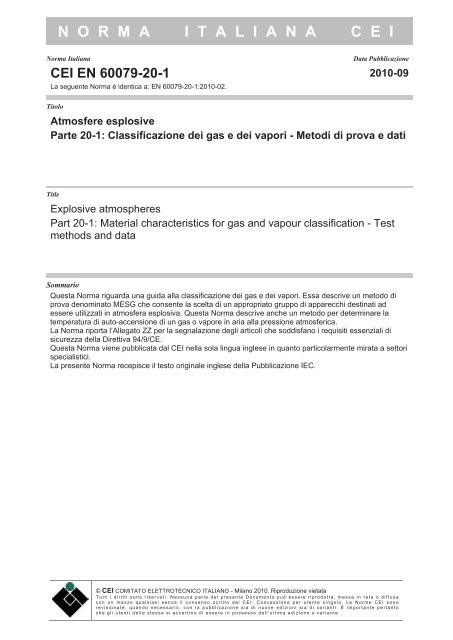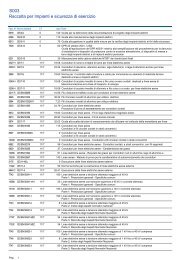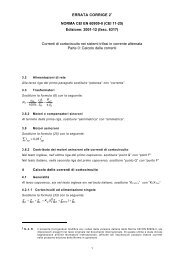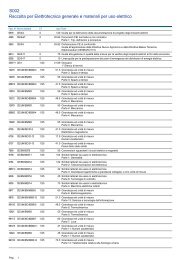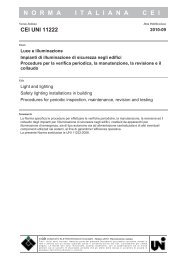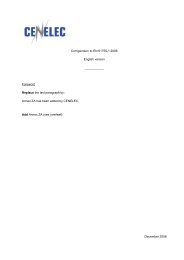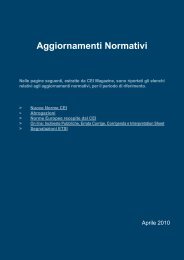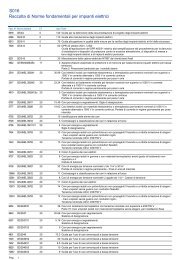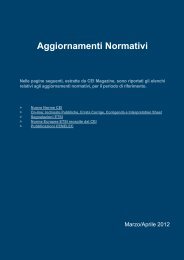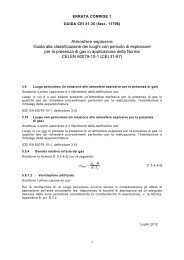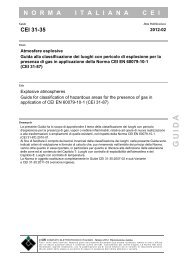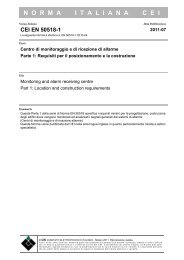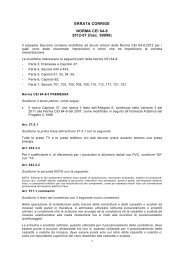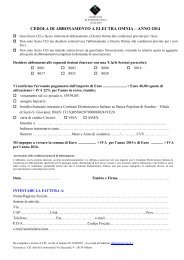EN 60079-20-1 - CEI
EN 60079-20-1 - CEI
EN 60079-20-1 - CEI
- No tags were found...
You also want an ePaper? Increase the reach of your titles
YUMPU automatically turns print PDFs into web optimized ePapers that Google loves.
N O R M A I T A L I A N A C E INorma ItalianaData Pubblicazione<strong>CEI</strong> <strong>EN</strong> <strong>60079</strong>-<strong>20</strong>-1 <strong>20</strong>10-09La seguente Norma è identica a: <strong>EN</strong> <strong>60079</strong>-<strong>20</strong>-1:<strong>20</strong>10-02.TitoloAtmosfere esplosiveParte <strong>20</strong>-1: Classificazione dei gas e dei vapori - Metodi di prova e datiTitleExplosive atmospheresPart <strong>20</strong>-1: Material characteristics for gas and vapour classification - Testmethods and dataSommarioQuesta Norma riguarda una guida alla classificazione dei gas e dei vapori. Essa descrive un metodo diprova denominato MESG che consente la scelta di un appropriato gruppo di apparecchi destinati adessere utilizzati in atmosfera esplosiva. Questa Norma descrive anche un metodo per determinare latemperatura di auto-accensione di un gas o vapore in aria alla pressione atmosferica.La Norma riporta l’Allegato ZZ per la segnalazione degli articoli che soddisfano i requisiti essenziali disicurezza della Direttiva 94/9/CE.Questa Norma viene pubblicata dal <strong>CEI</strong> nella sola lingua inglese in quanto particolarmente mirata a settorispecialistici.La presente Norma recepisce il testo originale inglese della Pubblicazione IEC.© <strong>CEI</strong> COMITATO ELETTROTECNICO ITALIANO - Milano <strong>20</strong>10. Riproduzione vietataTutti i diritti sono riservati. Nessuna parte del presente Documento può essere riprodotta, messa in rete o diffusacon un mezzo qualsiasi senza il consenso scritto del <strong>CEI</strong>. Concessione per utente singolo. Le Norme <strong>CEI</strong> sonorevisionate, quando necessario, con la pubblicazione sia di nuove edizioni sia di varianti. È importante pertantoche gli utenti delle stesse si accertino di essere in possesso dell’ultima edizione o variante.
DATI ID<strong>EN</strong>TIFICATIVI <strong>CEI</strong>Norma italiana <strong>CEI</strong> <strong>EN</strong> <strong>60079</strong>-<strong>20</strong>-1Classificazione <strong>CEI</strong> 31-90EdizioneCOLLEGAM<strong>EN</strong>TI/RELAZIONI TRA DOCUM<strong>EN</strong>TINazionaliEuropei (IDT) <strong>EN</strong> <strong>60079</strong>-<strong>20</strong>-1:<strong>20</strong>10-02;Internazionali (IDT) IEC <strong>60079</strong>-<strong>20</strong>-1:<strong>20</strong>10-01;LegislativiLegenda(IDT) - La Norma in oggetto è identica alle Norme indicate dopo il riferimento (IDT)INFORMAZIONI EDITORIALIPubblicazione Norma TecnicaStato Edizione In vigoreData validità 01-10-<strong>20</strong>10Ambito validitàFascicoloEd. Prec. Fasc.Comitato TecnicoInternazionale10681 <strong>EN</strong>essunaCT 31-Materiali antideflagrantiApprovata da Presidente del <strong>CEI</strong> In data 14-09-<strong>20</strong>10C<strong>EN</strong>ELEC In data 01-02-<strong>20</strong>10Sottoposta a Inchiesta pubblica come Documento originale Chiusura in data 18-12-<strong>20</strong>09ICS 29.260.<strong>20</strong>;2
EUROPEAN STANDARD <strong>EN</strong> <strong>60079</strong>-<strong>20</strong>-1NORME EUROPÉ<strong>EN</strong>NEEUROPÄISCHE NORM February <strong>20</strong>10ICS 29.260.<strong>20</strong>Recepita come <strong>CEI</strong> <strong>EN</strong> <strong>60079</strong>-<strong>20</strong>-1:<strong>20</strong>10-09English versionExplosive atmospheres -Part <strong>20</strong>-1: Material characteristics for gas and vapour classification -Test methods and data(IEC <strong>60079</strong>-<strong>20</strong>-1:<strong>20</strong>10)Atmosphères explosives -Partie <strong>20</strong>-1: Caractéristiquesdes substances pour le classementdes gaz et des vapeurs -Méthodes et données d'essai(<strong>CEI</strong> <strong>60079</strong>-<strong>20</strong>-1:<strong>20</strong>10)Explosionsfähige Atmosphären -Teil <strong>20</strong>-1: Stoffliche Eigenschaftenzur Klassifizierung von Gasenund Dämpfen -Prüfmethoden und Daten(IEC <strong>60079</strong>-<strong>20</strong>-1:<strong>20</strong>10)This European Standard was approved by C<strong>EN</strong>ELEC on <strong>20</strong>10-02-01. C<strong>EN</strong>ELEC members are bound to complywith the C<strong>EN</strong>/C<strong>EN</strong>ELEC Internal Regulations which stipulate the conditions for giving this European Standardthe status of a national standard without any alteration.Up-to-date lists and bibliographical references concerning such national standards may be obtained onapplication to the Central Secretariat or to any C<strong>EN</strong>ELEC member.This European Standard exists in three official versions (English, French, German). A version in any otherlanguage made by translation under the responsibility of a C<strong>EN</strong>ELEC member into its own language and notifiedto the Central Secretariat has the same status as the official versions.C<strong>EN</strong>ELEC members are the national electrotechnical committees of Austria, Belgium, Bulgaria, Croatia, Cyprus,the Czech Republic, Denmark, Estonia, Finland, France, Germany, Greece, Hungary, Iceland, Ireland, Italy,Latvia, Lithuania, Luxembourg, Malta, the Netherlands, Norway, Poland, Portugal, Romania, Slovakia, Slovenia,Spain, Sweden, Switzerland and the United Kingdom.C<strong>EN</strong>ELECEuropean Committee for Electrotechnical StandardizationComité Européen de Normalisation ElectrotechniqueEuropäisches Komitee für Elektrotechnische NormungCentral Secretariat: Avenue Marnix 17, B - 1000 Brussels© <strong>20</strong>10 C<strong>EN</strong>ELEC - All rights of exploitation in any form and by any means reserved worldwide for C<strong>EN</strong>ELEC members.Ref. No. <strong>EN</strong> <strong>60079</strong>-<strong>20</strong>-1:<strong>20</strong>10 E
Recepita come <strong>CEI</strong> <strong>EN</strong> <strong>60079</strong>-<strong>20</strong>-1:<strong>20</strong>10-09<strong>EN</strong> <strong>60079</strong>-<strong>20</strong>-1:<strong>20</strong>10 - 2 -ForewordThe text of document 31/837/FDIS, future edition 1 of IEC <strong>60079</strong>-<strong>20</strong>-1, prepared by IEC TC 31,Equipment for explosive atmospheres, was submitted to the IEC-C<strong>EN</strong>ELEC parallel vote and wasapproved by C<strong>EN</strong>ELEC as <strong>EN</strong> <strong>60079</strong>-<strong>20</strong>-1 on <strong>20</strong>10-02-01.Attention is drawn to the possibility that some of the elements of this document may be the subject ofpatent rights. C<strong>EN</strong> and C<strong>EN</strong>ELEC shall not be held responsible for identifying any or all such patentrights.The following dates were fixed:– latest date by which the <strong>EN</strong> has to be implementedat national level by publication of an identicalnational standard or by endorsement (dop) <strong>20</strong>10-11-01– latest date by which the national standards conflictingwith the <strong>EN</strong> have to be withdrawn (dow) <strong>20</strong>13-02-01This European Standard has been prepared under a mandate given to C<strong>EN</strong>ELEC by the EuropeanCommission and the European Free Trade Association and covers essential requirements ofEC Directive 94/9/EC. See Annex ZZ.Annexes ZA and ZZ have been added by C<strong>EN</strong>ELEC.__________Endorsement noticeThe text of the International Standard IEC <strong>60079</strong>-<strong>20</strong>-1:<strong>20</strong>10 was approved by C<strong>EN</strong>ELEC as a EuropeanStandard without any modification.__________
Recepita come <strong>CEI</strong> <strong>EN</strong> <strong>60079</strong>-<strong>20</strong>-1:<strong>20</strong>10-09- 3 - <strong>EN</strong> <strong>60079</strong>-<strong>20</strong>-1:<strong>20</strong>10Annex ZA(normative)Normative references to international publicationswith their corresponding European publicationsThe following referenced documents are indispensable for the application of this document. For datedreferences, only the edition cited applies. For undated references, the latest edition of the referenceddocument (including any amendments) applies.NOTE When an international publication has been modified by common modifications, indicated by (mod), the relevant <strong>EN</strong>/HDapplies.Publication Year Title <strong>EN</strong>/HD YearIEC <strong>60079</strong>-11 - Explosive atmospheres -Part 11: Equipment protection by intrinsicsafety "i"<strong>EN</strong> <strong>60079</strong>-11 -IEC <strong>60079</strong>-14 - Explosive atmospheres -Part 14: Electrical installations design,selection and erection<strong>EN</strong> <strong>60079</strong>-14 -
Recepita come <strong>CEI</strong> <strong>EN</strong> <strong>60079</strong>-<strong>20</strong>-1:<strong>20</strong>10-09<strong>EN</strong> <strong>60079</strong>-<strong>20</strong>-1:<strong>20</strong>10 - 4 -Annex ZZ(informative)Coverage of Essential Requirements of EC DirectivesThis European Standard has been prepared under a mandate given to C<strong>EN</strong>ELEC by the EuropeanCommission and the European Free Trade Association and within its scope the standard covers only thefollowing essential requirements out of those given in Annex II of the EC Directive 94/9/EC:– Essential Requirement 1.0.1– Essential Requirement 1.2.1, 1.2.3, 1.2.9 Essential Requirement 1.5.7Compliance with this standard provides one means of conformity with the specified essentialrequirements of the Directive(s) concerned.WARNING: Other requirements and other EC Directives may be applicable to the products falling withinthe scope of this standard.
Recepita come <strong>CEI</strong> <strong>EN</strong> <strong>60079</strong>-<strong>20</strong>-1:<strong>20</strong>10-09®IEC <strong>60079</strong>-<strong>20</strong>-1Edition 1.0 <strong>20</strong>10-01INTERNATIONALSTANDARDNORMEINTERNATIONALEExplosive atmospheres –Part <strong>20</strong>-1: Material characteristics for gas and vapour classification – Testmethods and dataAtmosphères explosives –Partie <strong>20</strong>-1: Caractéristiques des substances pour le classement des gaz et desvapeurs – Méthodes et données d’essaiINTERNATIONALELECTROTECHNICALCOMMISSIONCOMMISSIONELECTROTECHNIQUEINTERNATIONALEPRICE CODECODE PRIXXCICS 29.260.<strong>20</strong>ISBN 2-8318-1076-2® Registered trademark of the International Electrotechnical CommissionMarque déposée de la Commission Electrotechnique Internationale
Recepita come <strong>CEI</strong> <strong>EN</strong> <strong>60079</strong>-<strong>20</strong>-1:<strong>20</strong>10-09– 2 – <strong>60079</strong>-<strong>20</strong>-1 © IEC:<strong>20</strong>10CONT<strong>EN</strong>TSFOREWORD...........................................................................................................................41 Scope...............................................................................................................................62 Normative references .......................................................................................................63 Terms and definitions .......................................................................................................64 Classification of gases and vapours..................................................................................74.1 General ...................................................................................................................74.2 Classification according to the maximum experimental safe gaps (MESG)...............74.3 Classification according to the minimum igniting currents (MIC) ..............................84.4 Classification according to MESG and MIC..............................................................84.5 Classification according to a similarity of chemical structure....................................84.6 Classification of mixtures of gases ..........................................................................85 Data for flammable gases and vapours, relating to the use of equipment..........................95.1 Determination of the properties ...............................................................................95.1.1 General .......................................................................................................95.1.2 Equipment group .........................................................................................95.1.3 Flammable limits .........................................................................................95.1.4 Flash point FP .............................................................................................95.1.5 Temperature class.....................................................................................105.1.6 Minimum igniting current (MIC) ..................................................................105.1.7 Auto-ignition temperature ..........................................................................105.2 Properties of particular gases and vapours............................................................105.2.1 Coke oven gas ..........................................................................................105.2.2 Ethyl nitrite ................................................................................................105.2.3 MESG of carbon monoxide ........................................................................105.2.4 Methane, Group IIA ...................................................................................116 Method of test for the maximum experimental safe gap ..................................................116.1 Outline of method..................................................................................................116.2 Test apparatus ......................................................................................................116.2.1 General .....................................................................................................116.2.2 Mechanical strength ..................................................................................126.2.3 Interior chamber ........................................................................................126.2.4 Exterior chamber .......................................................................................126.2.5 Gap adjustment .........................................................................................126.2.6 Injection of mixture ....................................................................................126.2.7 Source of ignition ......................................................................................126.2.8 Materials of test apparatus ........................................................................126.3 Procedure .............................................................................................................126.3.1 Preparation of gas mixtures .......................................................................126.3.2 Temperature and pressure ........................................................................126.3.3 Gap adjustment .........................................................................................136.3.4 Ignition ......................................................................................................136.3.5 Observation of the ignition process............................................................136.4 Determination of maximum experimental safe gap (MESG) ...................................136.4.1 Preliminary tests........................................................................................136.4.2 Confirmatory tests .....................................................................................136.4.3 Reproducibility of maximum experimental safe gaps..................................13
Recepita come <strong>CEI</strong> <strong>EN</strong> <strong>60079</strong>-<strong>20</strong>-1:<strong>20</strong>10-09<strong>60079</strong>-<strong>20</strong>-1 © IEC:<strong>20</strong>10 – 3 –6.4.4 Tabulated values .......................................................................................136.5 Verification of the MESG determination method.....................................................147 Method of test for auto-ignition temperature ...................................................................147.1 Outline of method..................................................................................................147.2 Apparatus..............................................................................................................147.2.1 General .....................................................................................................147.2.2 Test flask...................................................................................................147.2.3 Furnace.....................................................................................................157.2.4 Thermocouples..........................................................................................157.2.5 Sampling syringes or pipettes....................................................................157.2.6 Timer.........................................................................................................157.2.7 Mirror ........................................................................................................157.3 Procedure .............................................................................................................157.3.1 Sample injection ........................................................................................157.3.2 Observations .............................................................................................167.3.3 Subsequent tests.......................................................................................167.3.4 Confirmatory tests .....................................................................................167.4 Auto-ignition temperature ......................................................................................167.5 Validity of results...................................................................................................167.5.1 Repeatability .............................................................................................167.5.2 Reproducibility...........................................................................................167.6 Data ......................................................................................................................177.7 Verification of the auto-ignition temperature determination method........................17Annex A (normative) Furnaces of test apparatus for the tests of auto-ignitiontemperature ..........................................................................................................................18Annex B (informative) Tabulated values...............................................................................26Bibliography..........................................................................................................................77Figure 1 – Test apparatus.....................................................................................................11Figure A.1 – Test apparatus: assembly .................................................................................19Figure A.2 – Section A-A (flask omitted) ...............................................................................<strong>20</strong>Figure A.3 – Base heater (board made of refractory material) ...............................................<strong>20</strong>Figure A.4 – Flask guide ring (board made of refractory material) .........................................21Figure A.5 – Neck heater (board made of refractory material) ...............................................22Figure A.6 – Furnace ............................................................................................................23Figure A.7 – Lid of steel cylinder...........................................................................................24Figure A.8 – Lid of steel cylinder...........................................................................................25Figure A.9 – Injection of gaseous sample..............................................................................25Table 1 – Classification of temperature class and range of auto-ignition temperatures..........10Table 2 – Values for verification of the apparatus .................................................................14Table 3 – Values for verification of the apparatus .................................................................17
Recepita come <strong>CEI</strong> <strong>EN</strong> <strong>60079</strong>-<strong>20</strong>-1:<strong>20</strong>10-09– 4 – <strong>60079</strong>-<strong>20</strong>-1 © IEC:<strong>20</strong>10INTERNATIONAL ELECTROTECHNICAL COMMISSION____________EXPLOSIVE ATMOSPHERES –Part <strong>20</strong>-1: Material characteristics for gasand vapour classification –Test methods and dataFOREWORD1) The International Electrotechnical Commission (IEC) is a worldwide organization for standardization comprisingall national electrotechnical committees (IEC National Committees). The object of IEC is to promoteinternational co-operation on all questions concerning standardization in the electrical and electronic fields. Tothis end and in addition to other activities, IEC publishes International Standards, Technical Specifications,Technical Reports, Publicly Available Specifications (PAS) and Guides (hereafter referred to as “IECPublication(s)”). Their preparation is entrusted to technical committees; any IEC National Committee interestedin the subject dealt with may participate in this preparatory work. International, governmental and nongovernmentalorganizations liaising with the IEC also participate in this preparation. IEC collaborates closelywith the International Organization for Standardization (ISO) in accordance with conditions determined byagreement between the two organizations.2) The formal decisions or agreements of IEC on technical matters express, as nearly as possible, an internationalconsensus of opinion on the relevant subjects since each technical committee has representation from allinterested IEC National Committees.3) IEC Publications have the form of recommendations for international use and are accepted by IEC NationalCommittees in that sense. While all reasonable efforts are made to ensure that the technical content of IECPublications is accurate, IEC cannot be held responsible for the way in which they are used or for anymisinterpretation by any end user.4) In order to promote international uniformity, IEC National Committees undertake to apply IEC Publicationstransparently to the maximum extent possible in their national and regional publications. Any divergencebetween any IEC Publication and the corresponding national or regional publication shall be clearly indicated inthe latter.5) IEC itself does not provide any attestation of conformity. Independent certification bodies provide conformityassessment services and, in some areas, access to IEC marks of conformity. IEC is not responsible for anyservices carried out by independent certification bodies.6) All users should ensure that they have the latest edition of this publication.7) No liability shall attach to IEC or its directors, employees, servants or agents including individual experts andmembers of its technical committees and IEC National Committees for any personal injury, property damage orother damage of any nature whatsoever, whether direct or indirect, or for costs (including legal fees) andexpenses arising out of the publication, use of, or reliance upon, this IEC Publication or any other IECPublications.8) Attention is drawn to the Normative references cited in this publication. Use of the referenced publications isindispensable for the correct application of this publication.9) Attention is drawn to the possibility that some of the elements of this IEC Publication may be the subject ofpatent rights. IEC shall not be held responsible for identifying any or all such patent rights.International Standard IEC <strong>60079</strong>-<strong>20</strong>-1 has been prepared by IEC technical committee 31:Equipment for explosive atmospheres.This first edition of IEC <strong>60079</strong>-<strong>20</strong>-1 cancels and replaces the first edition of IEC <strong>60079</strong>-1-1(<strong>20</strong>02), the second edition of IEC <strong>60079</strong>-4 (1975), its amendment 1(1995) and itscomplement: IEC <strong>60079</strong>-4A (1970), the first edition of IEC/TR <strong>60079</strong>-12 (1978) and the firstedition of IEC <strong>60079</strong>-<strong>20</strong> (1996). It constitutes a technical revision.
Recepita come <strong>CEI</strong> <strong>EN</strong> <strong>60079</strong>-<strong>20</strong>-1:<strong>20</strong>10-09<strong>60079</strong>-<strong>20</strong>-1 © IEC:<strong>20</strong>10 – 5 –The text of this standard is based on the following documents:FDIS31/837/FDISReport on voting31/855/RVDFull information on the voting for the approval of this standard can be found in the report onvoting indicated in the above table.This publication has been drafted in accordance with the ISO/IEC Directives, Part 2.A list of all parts of the IEC <strong>60079</strong> series, under the general title: Explosives atmospheres canbe found on the IEC website.The committee has decided that the contents of this publication will remain unchanged untilthe maintenance result date indicated on the IEC web site under "http://webstore.iec.ch" inthe data related to the specific publication. At this date, the publication will be• reconfirmed,• withdrawn,• replaced by a revised edition, or• amended.
– 6 – <strong>60079</strong>-<strong>20</strong>-1 © IEC:<strong>20</strong>10EXPLOSIVE ATMOSPHERES –Part <strong>20</strong>-1: Material characteristics for gasand vapour classification –Test methods and data1 ScopeThis part of IEC <strong>60079</strong> provides guidance on classification of gases and vapours. It describesa test method intended for the measurement of the maximum experimental safe gaps (MESG)for gas- or vapour-air mixtures under normal conditions of temperature 1 and pressure so as topermit the selection of an appropriate group of equipment. The method does not take intoaccount the possible effects of obstacles on the safe gaps 2 . This standard describes also atest method intended for use in the determination of the auto-ignition temperature of achemically pure vapour or gas in air at atmospheric pressure.The tabulated values of chemical and engineering properties of substances are provided toassist engineers in their selection of equipment to be used in hazardous areas. It is hoped topublish further data from time to time, as the results of tests made in several countriesbecome available.The scope of these data has been selected with particular reference to the use of equipmentin hazardous areas, and notice has been taken of standard measurement methods.NOTE 1 The data in this standard have been taken from a number of references which are given in thebibliography.NOTE 2 Some variations in the data may appear when references are compared, but usually the discrepancy issufficiently small to be of no importance in the selection of equipment.


